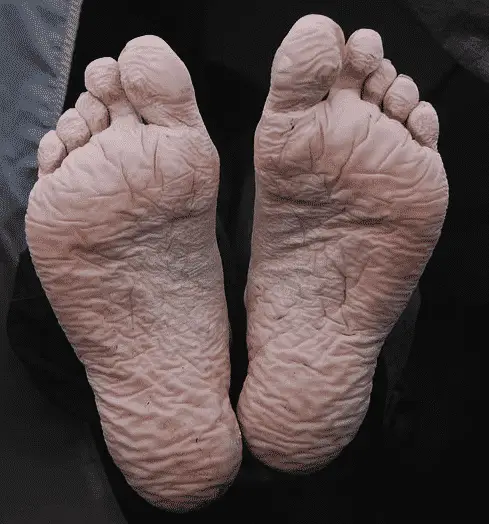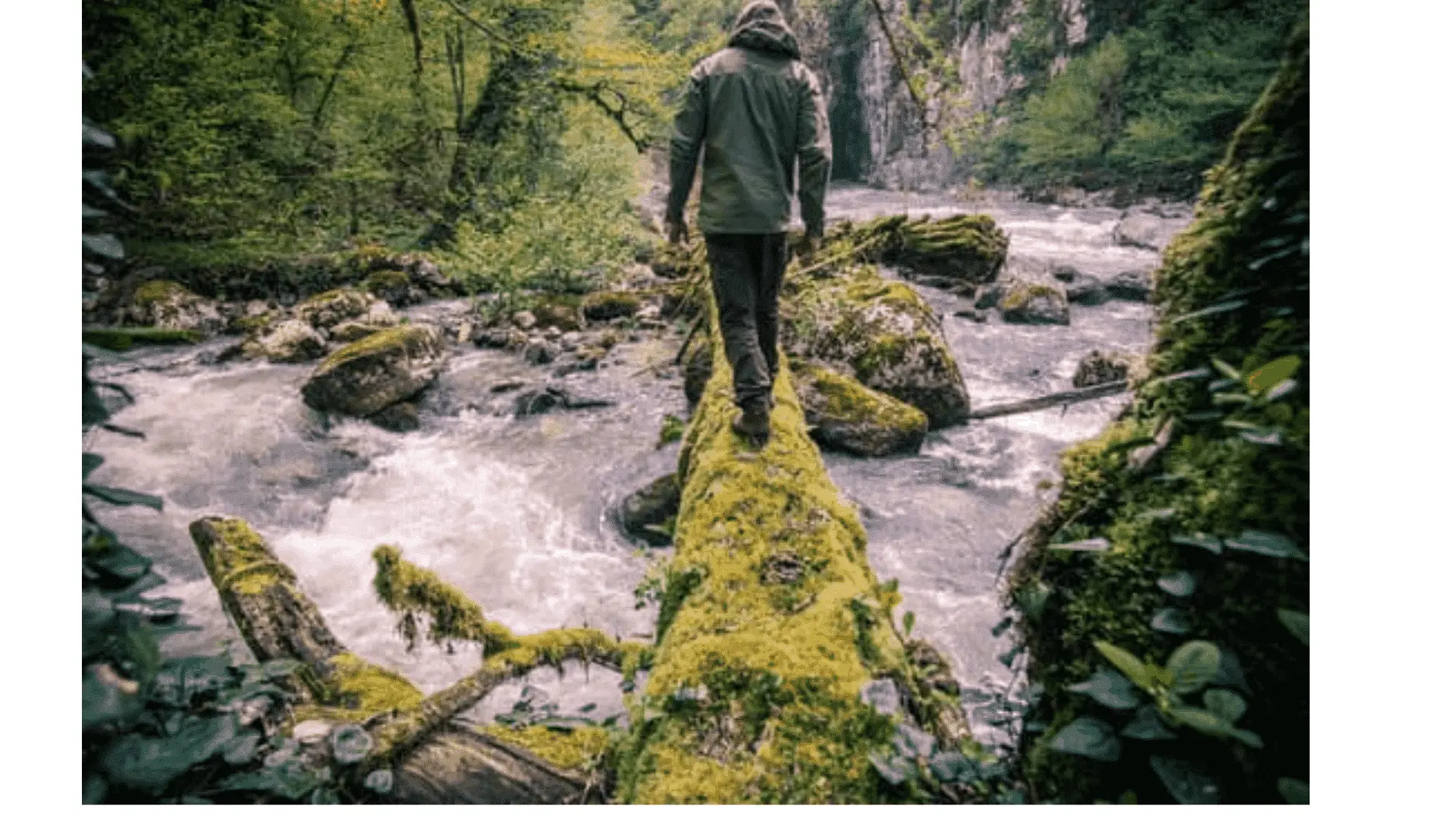If you go backpacking and camping regularly your feet will eventually get wet. There’s really nothing you can do about it, but don’t just ignore wet feet. Ignoring wet feet will eventually lead to immersion foot aka trench foot.
So, how do I prevent trench foot on a backpacking trip? You need to keep your feet dry, to prevent trench foot. Wear shoes that drain, moisture-wicking socks, and take good care of your feet on the trail. Adjust your hiking pace and give your feet plenty of time to dry.
Keeping your feet dry on the trail is easier said than done. I’ve seen the early signs of maceration just from sweat buildup after a summer hike. There’s just no getting around wet feet on a backpacking trip, but that doesn’t mean you should stop trying.
What you’re trying to do is prevent and manage macerations before they turn into full-blown trench foot. Start drying your feet before they get worse. In the rest of this article I will explain how I work to prevent and trench foot before it gets dangerous.
How to Prevent Trench Foot on Hiking and Backpacking Trips
Preventing trench foot on a backpacking trip isn’t all that difficult in. It all boils down to reducing moisture buildup and giving your feet enough time to dry.
I know that’s easier said than done during the rainy season, but with a few slight changes you should be able to significantly reduce the risk of trench foot. Before I get into preventing trench foot lets talk about recognizing it.
What is trench foot and how do I get it on a backpacking trip?

Immersion foot syndrome (aka trench foot), is a serious condition that’s caused by your feet feet being wet for an extended time period. It takes 2-3 days in seriously wet/cold conditions for trench foot to get bad.
The condition was first seen in World War 2 by soldiers that were stuck in wet trenches(hence the name). Without extra socks and boots they just couldn’t keep their feet dry.
According to this research study by the National Public Health Service for Wales and the Institute of Medical and Social Care Research, trench foot killed about 80,000 American and British soldiers during WW2. It’s really not something you want to mess around with and ignore.
Ever have wrinkly white feet after the end of a day on the trail? Those are the early warning signs of foot maceration which eventually leads to trench foot!
Signs of Trench Foot
Even though most immersion foot cases have different causes they all share the same symptoms. It doesn’t matter if you’re in saltwater, mud, or frozen streams. You have the exact sign same symptoms of trench foot.
- Extreme Maceration: Look for tears on the bottoms of your feet. The occasional tiny blister is normal, but full pad tears are not. Your feet shouldn’t look like a wrinkly white mess after a hike.
- Dermal Layer Separation: This looks very similar to a blister that hasn’t quite popped. The skin on the bottom of your feet starts to raise eventually tearing off.
- Redness, Tenderness and Swelling: Your feet will probably swell up a little bit after a hike, but it should quickly go back down. Your feet shouldn’t swell up like a balloon and feel tender to the touch.
- Open Sores, Blisters and Wrinkly Skin: There’s no good reason for your feet to blister up on a hike. This usually means that you chose terrible socks. Never wear cotton socks on a backpacking trip! Synthetic blends will work, but I highly recommend switching over to merino wool socks(my favorite merino wool socks).
When Should I Get Off The Trail?
Keep in mind that the early stages of foot maceration aren’t dangerous. Just because your feet are white and wrinkly doesn’t mean you have trench foot.
If there’s no swelling, redness and pain you should be fine with moderate intervention. It needs to be addressed, but it this point you don’t have immersion disease.
Just take off your socks and let your feet dry completely. Slowing down your pace, taking extra breaks and giving your feet time to dry should help.
You shouldn’t have much trouble on short weekend backpacking trips. Longer 4+ day trips is wear trench foot can really start to cause serious problems.
Trench Feet Can Get Bad Fast
Really think about how long your feet have looked white and wrinkly. If they’ve been macerated for several hours/days without improving you might be progressing into immersion disease. Trench feet usually takes 2-3 days before it gets really bad.
Once you start to see open sores, sloughing skin, swelling and general redness/tenderness it’s time to head back. At this point you won’t be able to reverse the symptoms on the trail.
You need to rest your feet for a few weeks and possibly see a doctor if you see signs of infection like blue/black discolered skin. It may take a few weeks for the damage to heal and new dermal layers of skin to grow back.
White/wrinkling skin is just an early warning sign before things get bad. Preventing and managing maceration should be your primary focus. You don’t want to end up with a full-blown case of immersion foot disease. That can lead to lead towards weeks/months of rehab and healing.
Preventing Trench Feet on The Trail
Preventing and curing trench feet is all about moisture control. Your goal is to prevent maceration before it gets bad. There are a number of things you can do to help, but it all boils down to reducing moisture buildup and giving your feet time to heal.
- Use Hydrophobic Balms: Hydrophobic balms are the first step in preventing trench foot, but they help at preventing all sorts of feet problems. I’ve been using Desitin on my feet and inner thighs for years and it works really well. Other people prefer the easy applicator with Body Glide’s Foot Glide, but it’s pricey for the size.
- Wear Merino Wool Socks: Synthetic moisture-wicking socks are fine in dry weather, but merino wool is so much better(Never wear cotton). Darn tough merino wool hiking socks are my favorite followed by People Socks which are slightly cheaper. Wool fibers absorb water, which keeps it off your feet and speeds up drying.
- Wear Shoes That Drain: Your shoes need to be able to drain out after they get wet. I really hate hiking in boots that are designed to be waterproof. Yes they keep a little bit of water out, but it will get in and never dry.
- Regularly Change Your Socks: I don’t get how some people only carry 2 pairs of socks. Yes, they will dry strapped to the back of your pack, but it’s so nice to put on fresh socks throughout the day. I usually like to carry 4 or 5 pairs of socks depending on trip length. This allows me to put on a dry pair of socks 2-3 times per day.
- Give Your Feet Time To Rest: Slow down your pace and take lots of breaks. Taking off your shoes and socks for a 5-10 minutes every couple of hours will make a world of difference. This won’t reverse the maceration process, but it will stop it from getting worse.
- Let Your Feet Dry At Night: Letting your feet dry at night is by far the best thing you can do on long multi-day hikes. Take your socks off at night and leave your wet socks out to dry. Bringing the wet socks into your sleeping bag should help dry them throughout the night.



